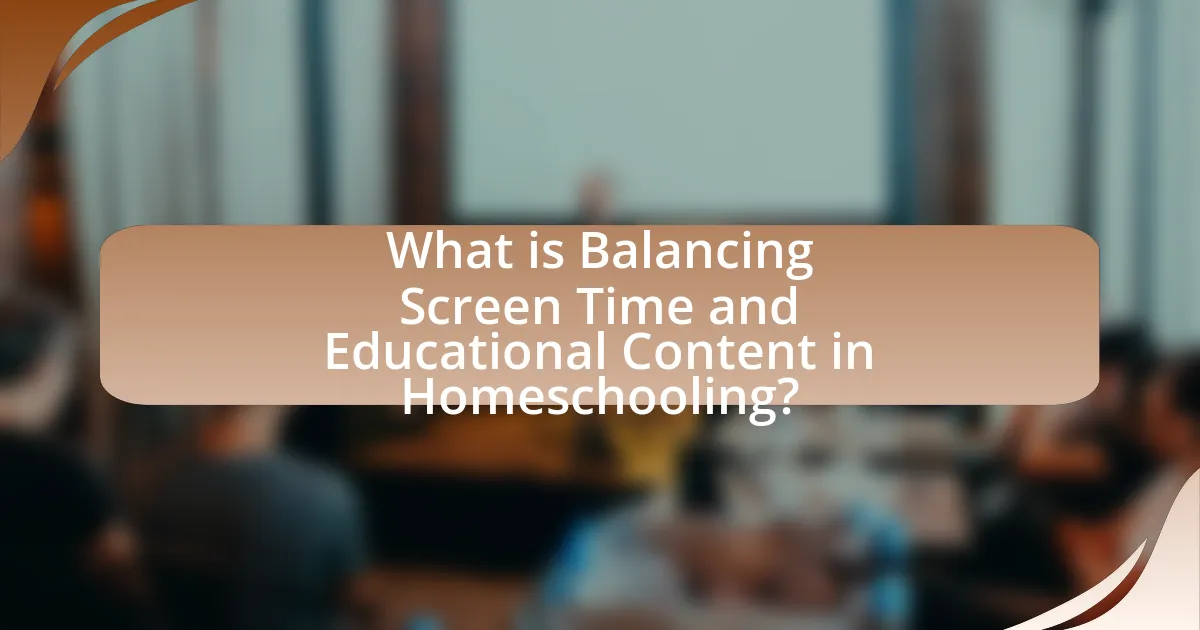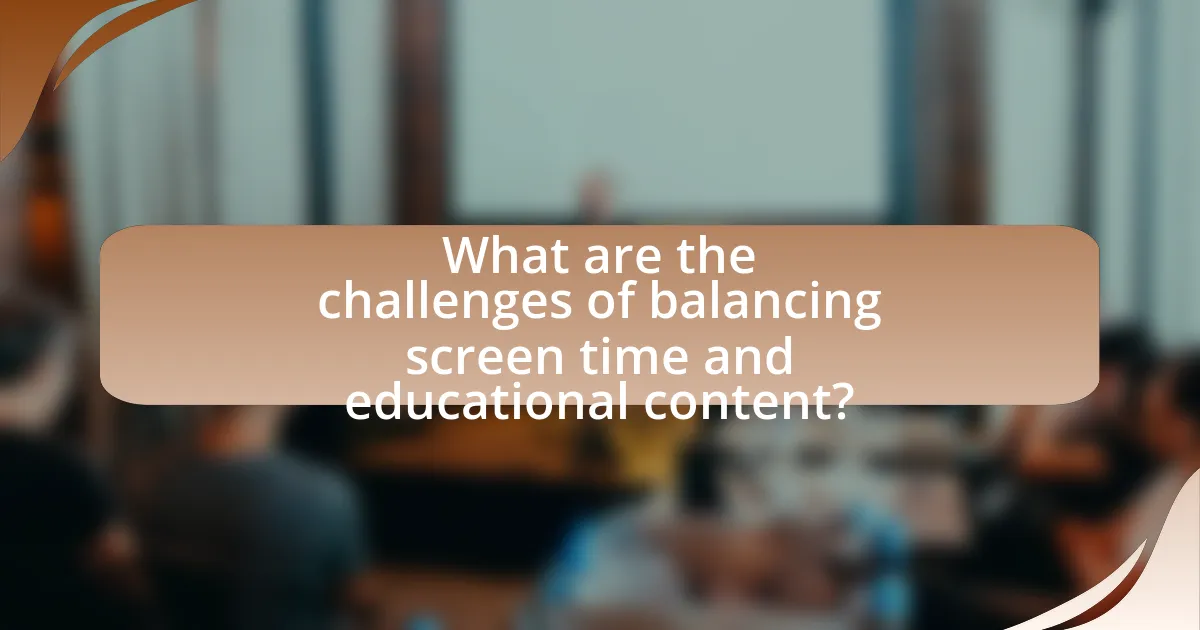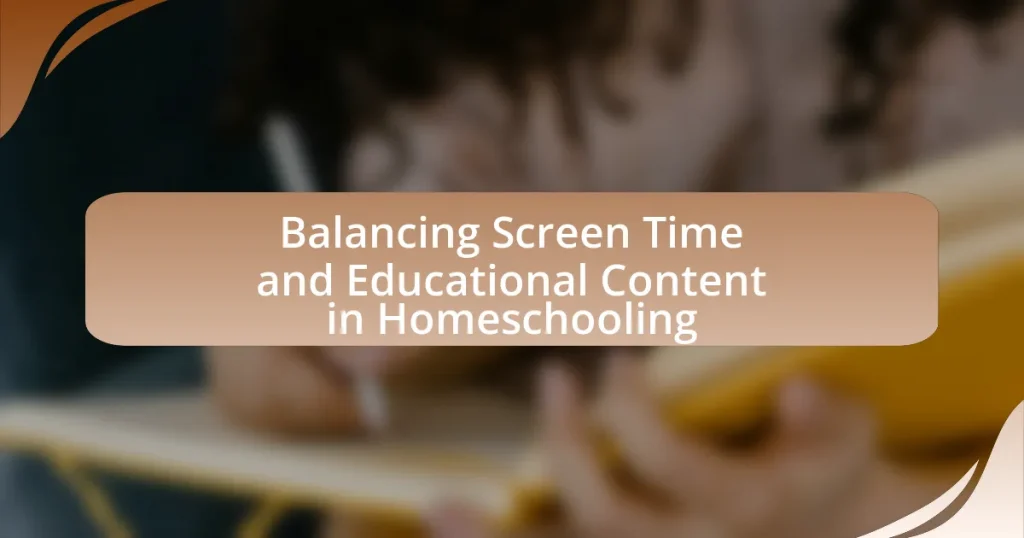Balancing screen time and educational content in homeschooling is essential for optimizing children’s learning experiences while mitigating the negative effects of excessive screen exposure. The article outlines the importance of managing screen time to prevent health issues and enhance cognitive development, emphasizing guidelines from the American Academy of Pediatrics. It discusses the potential risks associated with excessive screen use, the role of educational content in promoting active engagement, and strategies for parents to effectively balance screen time with offline activities. Additionally, it highlights the challenges parents face in finding quality educational resources and setting appropriate limits based on children’s age groups.

What is Balancing Screen Time and Educational Content in Homeschooling?
Balancing screen time and educational content in homeschooling involves managing the amount of time students spend on digital devices while ensuring that the content they engage with is educational and beneficial. This balance is crucial because excessive screen time can lead to negative health effects, such as eye strain and reduced physical activity, while educational content can enhance learning through interactive and engaging methods. Research indicates that children aged 2 to 5 should have no more than one hour of high-quality programming per day, as recommended by the American Academy of Pediatrics. Therefore, effective homeschooling requires a structured approach that incorporates educational screen time alongside traditional learning methods to optimize student engagement and learning outcomes.
Why is balancing screen time important in homeschooling?
Balancing screen time is important in homeschooling because excessive screen exposure can negatively impact children’s physical health, social skills, and cognitive development. Research indicates that children who spend more than two hours a day on screens may experience issues such as obesity, sleep disturbances, and reduced attention spans. For instance, a study published in the journal “Pediatrics” found that increased screen time correlates with higher rates of obesity among children, highlighting the need for moderation. Additionally, balancing screen time with offline activities fosters better social interactions and critical thinking skills, essential for holistic education.
What are the potential risks of excessive screen time?
Excessive screen time poses several potential risks, including negative impacts on physical health, mental well-being, and social skills. Research indicates that prolonged screen exposure can lead to issues such as obesity due to sedentary behavior, eye strain from blue light exposure, and disrupted sleep patterns. A study published in the journal “Pediatrics” found that children who spend more than two hours a day on screens are at a higher risk for behavioral problems and lower academic performance. Additionally, excessive screen time can hinder the development of social skills, as face-to-face interactions are reduced, leading to difficulties in communication and relationship-building.
How can screen time impact a child’s learning experience?
Screen time can significantly impact a child’s learning experience by influencing cognitive development, attention span, and social skills. Excessive screen time is associated with reduced attention spans, which can hinder a child’s ability to focus on educational tasks. Research from the American Academy of Pediatrics indicates that children who spend more than two hours a day on screens may experience negative effects on their academic performance and social interactions. Additionally, screen time can limit opportunities for hands-on learning and physical activity, both of which are crucial for holistic development. Therefore, managing screen time effectively is essential to enhance a child’s educational outcomes.
What role does educational content play in screen time management?
Educational content plays a crucial role in screen time management by providing purposeful engagement that enhances learning while limiting passive consumption. When educational content is prioritized, it encourages active participation and critical thinking, which can lead to more effective use of screen time. Research indicates that children who engage with educational media show improved cognitive skills and knowledge retention compared to those who consume non-educational content. For instance, a study published in the journal “Child Development” found that children who interacted with educational programming demonstrated better language skills and academic performance. Thus, integrating educational content into screen time not only helps manage the duration of use but also maximizes the educational benefits derived from that time.
What types of educational content are available for homeschooling?
Various types of educational content are available for homeschooling, including textbooks, online courses, educational videos, interactive software, and hands-on activities. Textbooks provide structured learning and are often aligned with state standards, while online courses offer flexibility and a wide range of subjects. Educational videos can enhance understanding through visual and auditory learning, and interactive software engages students through gamified learning experiences. Hands-on activities, such as experiments and projects, promote experiential learning and critical thinking skills. These diverse resources cater to different learning styles and help create a balanced educational experience for homeschooling families.
How can parents evaluate the quality of educational content?
Parents can evaluate the quality of educational content by assessing its alignment with educational standards and learning objectives. They should review the content for accuracy, relevance, and age-appropriateness, ensuring it meets the developmental needs of their children. Research indicates that high-quality educational content often incorporates interactive elements, promotes critical thinking, and is backed by credible sources, such as educational institutions or recognized experts in the field. For example, the American Academy of Pediatrics recommends that educational media should be designed to foster learning and development, emphasizing the importance of content that encourages active engagement rather than passive consumption.
How can parents effectively balance screen time and educational content?
Parents can effectively balance screen time and educational content by setting clear guidelines that prioritize educational activities while limiting recreational screen use. Research indicates that children aged 2 to 5 should have no more than one hour of high-quality programming per day, as recommended by the American Academy of Pediatrics. Parents can achieve this balance by scheduling specific times for educational content, such as interactive learning apps or educational videos, while designating separate times for recreational use. Additionally, engaging in discussions about the content viewed can enhance comprehension and retention, making screen time more productive.
What strategies can be implemented to manage screen time?
To manage screen time effectively, parents can implement strategies such as setting specific time limits, creating a schedule, and encouraging alternative activities. Research indicates that children aged 2 to 5 should have no more than one hour of high-quality programming per day, while older children benefit from consistent boundaries around screen use. Establishing a daily routine that includes designated screen time helps children understand expectations and promotes balance. Additionally, engaging children in physical activities, reading, or creative play can reduce reliance on screens and foster a more holistic approach to learning.
How can parents create a balanced schedule for screen use?
Parents can create a balanced schedule for screen use by setting specific time limits for different activities, ensuring a mix of educational content and recreational use. Research indicates that children aged 2 to 5 should have no more than one hour of high-quality programming per day, while older children benefit from a structured approach that includes both screen time and offline activities. By incorporating breaks and encouraging physical activity, parents can promote a healthier balance, aligning with guidelines from the American Academy of Pediatrics, which emphasize the importance of active engagement and parental involvement in media consumption.

What are the challenges of balancing screen time and educational content?
Balancing screen time and educational content presents challenges such as ensuring that the time spent on screens is productive and not merely recreational. Parents and educators often struggle to find appropriate educational resources that engage students while limiting distractions from non-educational content. Research indicates that excessive screen time can lead to negative outcomes, including reduced attention spans and decreased academic performance, as highlighted in a study by the American Academy of Pediatrics, which found that children who spend more than two hours a day on screens are at risk for these issues. Additionally, the rapid pace of technological change makes it difficult for parents to keep up with effective educational tools, leading to inconsistencies in the quality of content consumed.
What common obstacles do parents face in managing screen time?
Parents commonly face several obstacles in managing screen time, including setting consistent limits, competing distractions, and varying child interests. Establishing consistent limits is challenging due to the pervasive nature of screens in daily life, making it difficult for parents to enforce rules. Competing distractions arise from the availability of multiple devices and platforms, which can lead to excessive screen use. Additionally, children’s varying interests in digital content can complicate parents’ efforts to prioritize educational material over entertainment, as children may resist restrictions on their preferred activities. These factors contribute to the overall difficulty in achieving a balanced approach to screen time management.
How can distractions from non-educational content be minimized?
Distractions from non-educational content can be minimized by implementing structured screen time schedules and utilizing content filtering tools. Structured schedules help allocate specific times for educational activities, reducing the likelihood of wandering into non-educational content. For instance, research indicates that children who follow a consistent routine are more focused and engaged in learning (American Academy of Pediatrics, 2016). Content filtering tools, such as parental controls and educational apps, can block access to distracting websites and applications, ensuring that the learning environment remains focused on educational material. By combining these strategies, distractions can be effectively reduced, promoting a more productive homeschooling experience.
What are the difficulties in finding suitable educational resources?
Finding suitable educational resources is challenging due to the overwhelming volume of available content, which can lead to information overload. Parents and educators often struggle to discern high-quality materials from subpar ones, as many resources lack proper accreditation or evidence-based methodologies. Additionally, the rapid evolution of technology and educational standards complicates the selection process, making it difficult to keep resources current and relevant. Research indicates that 70% of parents express concerns about the quality of online educational content, highlighting the need for reliable evaluation criteria to navigate this landscape effectively.
How do different age groups affect screen time balance?
Different age groups significantly influence screen time balance due to varying developmental needs and cognitive abilities. For instance, children aged 2 to 5 typically require limited screen time, recommended at one hour of high-quality programming per day, as excessive exposure can hinder language development and social skills. In contrast, children aged 6 to 18 may benefit from increased screen time for educational purposes, with guidelines suggesting that parents monitor usage to ensure it does not exceed two hours of recreational screen time daily. Research from the American Academy of Pediatrics indicates that appropriate screen time can enhance learning when combined with parental guidance, thus emphasizing the need for age-appropriate limits to maintain a healthy balance between screen use and other activities.
What screen time guidelines are recommended for younger children?
The American Academy of Pediatrics (AAP) recommends that children aged 2 to 5 years should have no more than one hour of high-quality programming each day. This guideline emphasizes the importance of engaging content that promotes learning and development. For children younger than 18 months, the AAP advises avoiding the use of screen media other than video chatting, as early exposure can hinder language development and social skills. These recommendations are based on research indicating that excessive screen time can negatively impact cognitive and social development in young children.
How should screen time be adjusted for older students?
Screen time for older students should be adjusted to a maximum of 2 hours per day for recreational use, while ensuring that educational screen time is purposeful and aligned with learning objectives. Research indicates that excessive screen time can lead to negative outcomes such as decreased attention span and poorer academic performance. The American Academy of Pediatrics recommends that screen time for educational purposes should be balanced with offline activities to promote overall well-being and cognitive development.

What best practices can enhance the balance of screen time and educational content?
To enhance the balance of screen time and educational content, parents should implement structured schedules that allocate specific time slots for educational activities and recreational screen use. Research indicates that children benefit from a balanced approach, where educational content is prioritized during designated learning periods, such as using educational apps or watching instructional videos, while recreational screen time is limited to ensure it does not interfere with academic engagement. For instance, the American Academy of Pediatrics recommends that children aged 2 to 5 should have no more than one hour of high-quality programming each day, emphasizing the importance of co-viewing to facilitate discussions about the content. This structured approach not only maximizes learning outcomes but also helps children develop healthy screen habits.
How can parents incorporate interactive learning into screen time?
Parents can incorporate interactive learning into screen time by selecting educational apps and programs that promote engagement through quizzes, games, and problem-solving activities. Research indicates that interactive content enhances cognitive skills and retention; for instance, a study published in the Journal of Educational Psychology found that students using interactive learning tools scored 20% higher on assessments compared to those using traditional methods. By choosing platforms that encourage active participation, parents can ensure that screen time is both enjoyable and educational, fostering a productive learning environment at home.
What tools and resources can support interactive learning?
Interactive learning can be supported by tools such as educational software, online platforms, and interactive multimedia resources. Educational software like Kahoot! and Quizlet enables real-time quizzes and flashcards, fostering engagement through gamification. Online platforms such as Google Classroom and Edmodo facilitate collaboration and communication among students and teachers, enhancing the learning experience. Interactive multimedia resources, including videos from platforms like Khan Academy and interactive simulations from PhET, provide visual and hands-on learning opportunities that cater to various learning styles. These tools have been shown to improve student motivation and retention of information, making them effective in promoting interactive learning.
How can parents encourage active participation during screen time?
Parents can encourage active participation during screen time by engaging children in interactive activities that require their input and critical thinking. For instance, parents can choose educational apps or programs that include quizzes, discussions, or problem-solving tasks, which promote active involvement rather than passive consumption. Research indicates that interactive screen time can enhance learning outcomes; a study published in the Journal of Educational Psychology found that children who engaged with interactive content demonstrated better retention of information compared to those who viewed non-interactive material. By selecting content that fosters interaction and discussing it with their children, parents can significantly enhance the educational value of screen time.
What tips can help maintain a healthy balance in homeschooling?
To maintain a healthy balance in homeschooling, establish a structured daily schedule that includes designated times for both educational activities and breaks. This approach helps ensure that children receive a well-rounded education while also allowing time for physical activity and relaxation. Research indicates that children benefit from a balanced routine, as it can enhance focus and retention of information. For instance, the American Academy of Pediatrics recommends that children engage in at least 60 minutes of physical activity each day, which can be integrated into homeschooling schedules to promote overall well-being.
How can parents set clear boundaries for screen use?
Parents can set clear boundaries for screen use by establishing specific time limits and designated screen-free zones. Research indicates that children benefit from structured screen time, with the American Academy of Pediatrics recommending no more than one hour of high-quality programming for children aged 2 to 5 years, and consistent limits for older children. By creating a family media plan that outlines when and where screens can be used, parents can promote healthier habits and ensure that screen time is balanced with other activities.
What role does parental involvement play in managing screen time?
Parental involvement plays a crucial role in managing screen time by setting boundaries and guiding children’s media consumption. Research indicates that children with actively engaged parents tend to have healthier screen time habits, as parents can establish rules, monitor content, and encourage educational use of screens. A study published in the journal “Pediatrics” found that children whose parents set consistent limits on screen time were less likely to engage in excessive use, leading to better physical and mental health outcomes. Thus, active parental participation is essential for fostering a balanced approach to screen time in the context of homeschooling.










